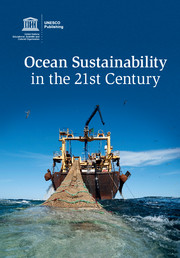Book contents
- Frontmatter
- Contents
- List of contributors
- Acronyms and abbreviations
- Foreword by Irina Bokova, Director-General of UNESCO
- Foreword by Thomas E. Lovejoy
- Preface
- Acknowledgements
- 1 Issues regarding oceans and opportunities: an introduction to the book
- 2 Main human uses of ocean areas and resources, impacts, and multiple scales of governance
- 3 Physical and chemical changes in the ocean over basin-wide zones and decadal or longer time-scales: perspectives on current and future conditions
- 4 Knowledge and implications of global change in the oceans for biology, ecology, and ecosystem services
- 5 A new perspective on changing Arctic marine ecosystems: panarchy adaptive cycles in pan-Arctic spatial and temporal scales
- 6 Ecosystem approach and ocean management
- 7 Challenges in using valuation in ecosystem-based management in a marine context: the case of UK Marine Protected Area designation
- 8 The contribution of international scientific cooperation and related institutions to effective governance for the oceans: the cases of regional tsunami early warning systems and the Argo project
- 9 Emerging and unresolved issues: the example of marine genetic resources of areas beyond national jurisdiction
- 10 The assumption that the United Nations Convention on the Law of the Sea is the legal framework for all activities taking place in the sea
- 11 The legal regime of outer space in light of the Law of the Sea
- 12 Towards sustainable oceans in the 21st century
- Index
- References
2 - Main human uses of ocean areas and resources, impacts, and multiple scales of governance
Published online by Cambridge University Press: 05 May 2015
- Frontmatter
- Contents
- List of contributors
- Acronyms and abbreviations
- Foreword by Irina Bokova, Director-General of UNESCO
- Foreword by Thomas E. Lovejoy
- Preface
- Acknowledgements
- 1 Issues regarding oceans and opportunities: an introduction to the book
- 2 Main human uses of ocean areas and resources, impacts, and multiple scales of governance
- 3 Physical and chemical changes in the ocean over basin-wide zones and decadal or longer time-scales: perspectives on current and future conditions
- 4 Knowledge and implications of global change in the oceans for biology, ecology, and ecosystem services
- 5 A new perspective on changing Arctic marine ecosystems: panarchy adaptive cycles in pan-Arctic spatial and temporal scales
- 6 Ecosystem approach and ocean management
- 7 Challenges in using valuation in ecosystem-based management in a marine context: the case of UK Marine Protected Area designation
- 8 The contribution of international scientific cooperation and related institutions to effective governance for the oceans: the cases of regional tsunami early warning systems and the Argo project
- 9 Emerging and unresolved issues: the example of marine genetic resources of areas beyond national jurisdiction
- 10 The assumption that the United Nations Convention on the Law of the Sea is the legal framework for all activities taking place in the sea
- 11 The legal regime of outer space in light of the Law of the Sea
- 12 Towards sustainable oceans in the 21st century
- Index
- References
Summary
2.1 Introduction
The global ocean provides humankind with vital ecosystem goods and services that include the regulation of the Earth's climate, as well as provision of food and other goods, recreation, and spiritual values. The ocean is not only important for the Earth' s economy, but also its environmental balance and survival (Noone et al., 2013).
Human uses of the ocean include fishing (food), shipping, scientific research, the use of genetic resources, mining, underwater cables, energy, water, and recreation. While all those involved in these uses can be considered as ocean stakeholders, the concept of stakeholder is broader than just direct use. Stakeholders can include groups affected by management decisions; groups concerned by management decisions; groups dependent on the resources to be managed; groups with claims over the area of resources; groups with activities that impact on the area or resources; and groups with, for example, special seasonal or geographic interests (Vierros et al., 2006). Ultimately, however, the entire population of the Earth depends in one way or another on the ocean for their survival, due to the climate regulating and oxygen providing services of these areas, and can thus be considered to be stakeholders.
Preserving and maintaining the services provided by the ocean will require integrated, ecosystem-based management approaches and governance structures at both global and local levels, which will take into account both direct human uses and conservation needs, as well as global benefits. Many habitats and species in the ocean are highly threatened by human activities, and the current governance regime is not sufficient and in many cases too fragmented to provide for effective management and protection of multiple and emerging threats
2.2 Value and use of ocean areas, and environmental impacts of use
The goods and services provided by the ocean range from climate regulation to food, and recreational and spiritual value. For example, an analysis undertaken by The Economics of Ecosystems and Biodiversity (TEEB) project, found the value of coral reefs to humankind to be between US$130,000 and $1.2 million per hectare, per year (Diversitas, 2009).
- Type
- Chapter
- Information
- Ocean Sustainability in the 21st Century , pp. 21 - 53Publisher: Cambridge University PressPrint publication year: 2015



